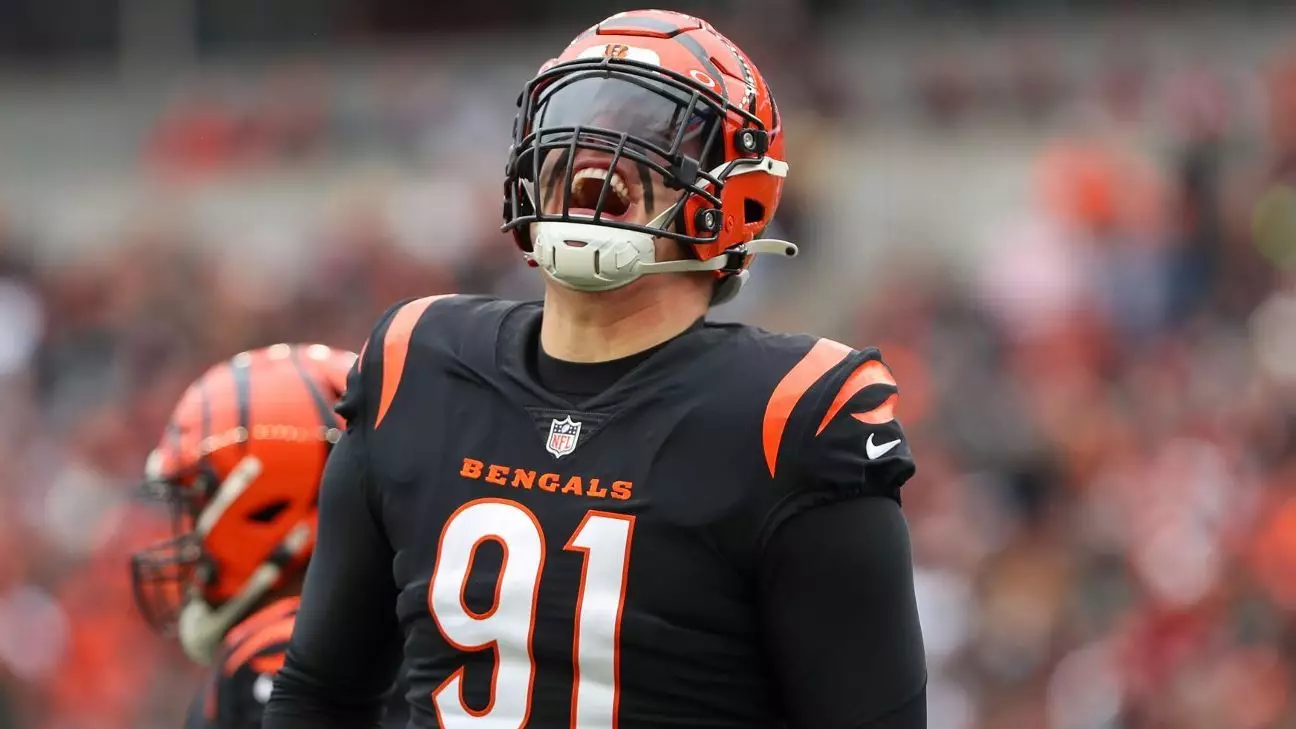In the high-stakes world of professional football, contract negotiations can often resemble a game of chess, with players and management strategizing over pieces that are as valuable as the athletes themselves. The Cincinnati Bengals find themselves in such a tense situation with defensive end Trey Hendrickson, a player who has proven his worth on the field. After leading the NFL with 17.5 sacks last season and earning a spot on the All-Pro team, Hendrickson understandably sought a new deal more reflective of his contributions. However, recent statements indicate a breakdown in communication that could jeopardize not only his relationship with the organization but also the team’s overall performance in the upcoming season.
Hendrickson announced that all contract discussions have been halted following the completion of the NFL draft, a puzzling development for a player coming off his finest season. In his own words, there has been a complete void of communication between his representation and the Bengals’ management. Such a lack of dialogue raises eyebrows, especially considering the franchise’s willingness to extend lucrative contracts to other players. Most notably, Ja’Marr Chase recently inked a record-breaking $161 million deal, raising questions about Hendrickson’s place in the organization’s priorities.
The Perils of Public Discontent
Instead of leveraging the opportunity to engage in fruitful discussions, both parties appear to be entangled in a standoff that may cost them both. Hendrickson has voiced his frustration over the Bengals’ apparent unwillingness to meet his needs. He noted that the offers presented thus far did not align with the promises made to him about the team’s vision moving forward. This disconnect signifies more than mere financial matters; it points to deeper issues regarding the organization’s commitment to its star players.
Communication, as Hendrickson emphasized, is vital in any negotiation, yet the absence of it poses a real risk of creating resentment within the locker room. It’s alarming that not only have talks stalled, but the lines of communication have deteriorated to such an extent that essential discussions aren’t even happening. Such scenarios can lead to discord among teammates and affect team morale as players note the unequal treatment of their peers. The Bengals, as an organization, need to recognize this danger and prioritize open dialogue, lest they find themselves in a situation where key players feel undervalued or alienated.
Revisiting Executive Perspectives
The sentiments expressed by Bengals executive Katie Blackburn during the NFL’s annual league meeting only compounded the issue. Blackburn hinted that Hendrickson might need to adjust his expectations to align them with the team’s offerings. Such comments can easily be perceived as dismissive, particularly when taken alongside Hendrickson’s assertion of poor communication with the organization’s higher-ups. To be frank, Blackburn’s remarks could be construed as a refusal to acknowledge the gravity of the situation.
In an environment as fiercely competitive as the NFL, expectations on both ends should be rooted in mutual respect and acknowledgment of a player’s contributions. Hendrickson’s eagerness to resolve the contract controversy suggests a desire to remain in Cincinnati despite any roadblocks, highlighting an essential quality for any team: loyalty. The denial of discussions inevitably raises questions about how much value the Bengals place on players who deliver outstanding performances consistently.
The Bigger Picture: More Than Just One Player
While Hendrickson’s contract situation is undoubtedly pivotal, it serves as a microcosm of larger issues at play within the organization. The Bengals have other players—specifically, Shemar Stewart, the NFL draft’s 17th pick—who are also dealing with unsigned contracts. This parallel only intensifies the urgency for the team to address contract disputes promptly to prevent further agitation among players, leading to a fractious locker room atmosphere.
Considering the upcoming organized team activities, Hendrickson’s absence could have implications for the team’s cohesion. A lack of unity during this critical period could derail their momentum heading into the season. For a franchise that has shown promise in recent years, upholding the standard of communication and negotiation becomes essential not just for retaining talent but also for instilling a culture of trust and respect—two components vital for any football team aiming for success.
In navigating this evolving narrative, the Bengals must take stock of their priorities and strategies. They must ask themselves: are they focused solely on the bottom line, or do they genuinely value the players who bring their game to life? The answer to that question will shape the future trajectory of both Hendrickson and the franchise as a whole.

